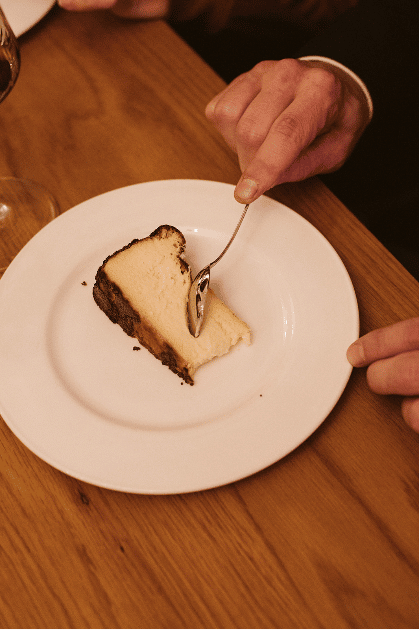How to make the perfect Basque Cheesecake: a step-by-step recipe
- San Sebastian's Cheesecake



Originating in San Sebastian, this cheesecake sensation boasts a caramelized exterior with a creamy, flan-like or creme-brulee interior—simply irresistible. With minimal ingredients, it’s your chance to shine as a home baker. Watch our video for our take on this recipe and tips. Plus, for the ultimate adventure, join us in San Sebastian for an exclusive food tour. Taste the legend firsthand.
When I moved to San Sebastian over a decade ago I would go to La Viña for this cheesecake whenever I was homesick. It was comforting and it brought a weird feeling of peace. Maybe it’s because it’s so good you can’t really think of anything else when you taste it.
I hope you enjoy making it at home.
Ingredients
- 300 g of sugar (1 ¾ cups)
- 1 kg (2 ¼ pounds) of cream cheese, room temperature
- Pinch of salt or ¼ teaspoon
- 7 small eggs
You can adjust based on size. I used 7 small eggs, but 4-5 larger eggs worked too. - 500 mL (2 cups) heavy cream
- 20 g (¼ cup) purpose flour *It also works without flour
Recipe instructions
- Preheat your oven to 230°C (400F).
- Run 2 sheets of parchment paper through water, squeeze excess water out, and cover the baking tin leaving about 5 cm (2 inches) of overhang around the sides of the pan. Allow your paper to pleat where it naturally creases. This is the only ¨decoration¨ it has.
- In a large bowl, mix by hand (preferred) or use a stand mixer fitted with the paddle attachment. Blend the granulated sugar and cream cheese until the mixture is smooth.
- Add the salt into the mixture.
- Add the eggs to the mixture one at a time, ensuring each egg is fully incorporated before adding the next. Keep in mind that the goal is to avoid overmixing. Mixing by hand is recommended to prevent incorporating too much air.
- Pour in the heavy cream and gently whisk until well combined.
- Sift the all-purpose flour over the mixture and carefully fold it in, maintaining a light touch to avoid overmixing.
- Pour the batter into the prepared springform pan. Place it in the preheated oven at the highest level and push it all the way to the back of the oven. Bake for approximately 15 minutes, or until the top is browned and develops a slightly burnt appearance. Keep an eye on the cheesecake from the 15-minute mark onward, as baking times can vary based on your oven. Once it’s caramelized on the top turn the oven off and leave it to continue cooking with the residue heat for another 15 minutes. The center will be very jiggly, but the cake is done.
- Once baked, remove the cheesecake from the oven and allow it to cool. At least 5 hours.
- Put in the fridge overnight.
- Eat at room temperature. Allow it to reach room temperature when you bring it out of the fridge. Carefully remove the outer part of the springform pan and gently peel away the parchment paper.
- To serve, present the cheesecake at room temperature. You can pair it with a dessert wine like Pedro Ximenez like we do in San Sebastian. Try pouring a bit of it onto the cheesecake. *Bliss! Or try it with a digestif you like, tea or coffee.
Variations
- This recipe is versatile. You can adjust the sweetness level or experiment with different ingredients.
- Consider adding matcha, real vanilla, cinnamon, or even incorporating a crust of cookies and nuts.
- Feel free to modify the cheese. For instance, you can use a mix of 1/3 blue cheese and the rest cream cheese, or even goat’s cheese. Ensure a balance of fats and proteins for the base using cream cheese as a base ingredient.
- The Basque Burnt Cheesecake is an exciting canvas for culinary creativity, allowing you to customize flavors and ingredients to your liking. Part of its magic is the texture and the relaxed look. I like to think of how this recipe came from Santiago, the current owner of La Viña being free to experiment and combine many recipes. Who know makye you’ll coin the next flavour of the year in the New York Times.
Still hungry? Here’s more
The Language of Pintxos: Discovering Euskera in San Sebastian
Ever heard a language so unique that it has no known relatives? Welcome to the
From a Year of Flavour and Impact in 2024 to Celebrating 2025 with the Joy of The Tamborrada
Agur (Goodbye) 2024. Kaixo (Hello) 2025! Here’s to making resolutions that make sense to you,

